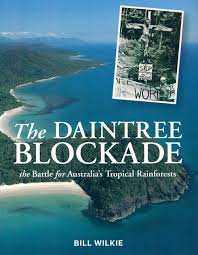
The Daintree Blockade
The battle for Australia's tropical rainforests
20 May 2017
In December 1983 a small group of local Daintree residents formed a peaceful protest when the Douglas Shire Council, with the support of the Bjelke Petersen State Government, commenced work on a road from Cape Tribulation to Bloomfield in Australia’s tropical north east, about two hours north of Cairns. As an aside, Bjelke Petersen was the longest-serving Queensland Premier (1968–1987); was vocal in calling for Whitlam’s sacking in ‘75; and was openly antagonistic towards the new federal Labor Government (1983–1996). In opposition, Bob Hawke had, in part, campaigned to stop the Franklin Dam in Tasmania. On July 1 1983 the High Court ruled that the Federal Government can legislate on issues if such legislation is necessary to enforce international treaties. This decision and the Hawke Government’s halting of the Franklin had implications for the Daintree.
Known as the Cape Tribulation–Bloomfield Road, or the Bloomfield Track, the road was slated to go through one of the last remaining areas of tropical lowland rainforest in the country (Wet Tropics), and traverse the recently declared Cape Tribulation National Park. The road had been proposed a number of times previously, so the idea wasn’t new, but the move by Council to begin construction right before the Wet caught many by surprise. The initial action halted construction, the police moved in and protesters were arrested. Council’s decisions and the protest actions set off almost a year-long dispute, and the small blockade soon escalated into a full-scale confrontation, which came to be known as the Daintree Blockade.
Those opposed to the road said it would bring unwanted development to an area of high environmental significance. Those in favour saw it as a way to speed up such development. Conservationists literally put their bodies on the line, by maintaining vigils up trees and burying themselves up to their necks in front of the ‘dozers. The blockade included a national campaign to educate people about the exceptional nature of the Daintree Rainforest. The campaign lasted close to ten years, brought ongoing national and international attention to the issue and resulted in the area being World Heritage listed on December 9, 1988.
The Queensland Government initially opposed the listing and took the issue to the High Court to try and stop it, but that was unsuccessful. According to UNESCO the Wet Tropics covers less than 0.2% of the continent, but contains 30% of the marsupial species; 60% of bat species; 25% of rodent species; 40% of bird species; 30% of frog species; 20% of reptile species; 60% of butterfly species; 65% of fern species; 21% of cycad species; 37% of conifers; 30% of orchid species; and 18% of Australia’s vascular plant species — and is home to the Cassowary. It’s clearly ecologically and scientifically significant, if not downright essential.
The road was completed in 1984 — as an alternative to the inland Mulligan Highway — and connects Cape Tribulation to Cooktown. It’s only partially sealed so can be impassable after heavy rains.
Bill Wilkie — a Mossman-based writer and independent publisher — has been researching the Daintree Blockade for over four years. Drawing on over 80 interviews; personal letters and firsthand accounts; newspaper reports; and previously untapped archives, The Daintree Blockade: the battle for Australia’s tropical rainforests is the defining account of those battles. And 4zzz’s Steve Stockwell was on the scene. Many of 4zzz’s reports helped inform Bill’s book.
The Daintree Blockade is available now. To order copies or for more information about the Daintree Blockade itself visit www.daintreeblockade.com.au or go to The Daintree Blockade Book Facebook page. You can read and hear more about the protest on FNQ local ABC Radio; on the Cairns Far North Environment Centre (CAFNEC) website; and on the UNESCO World Heritage Convention site.